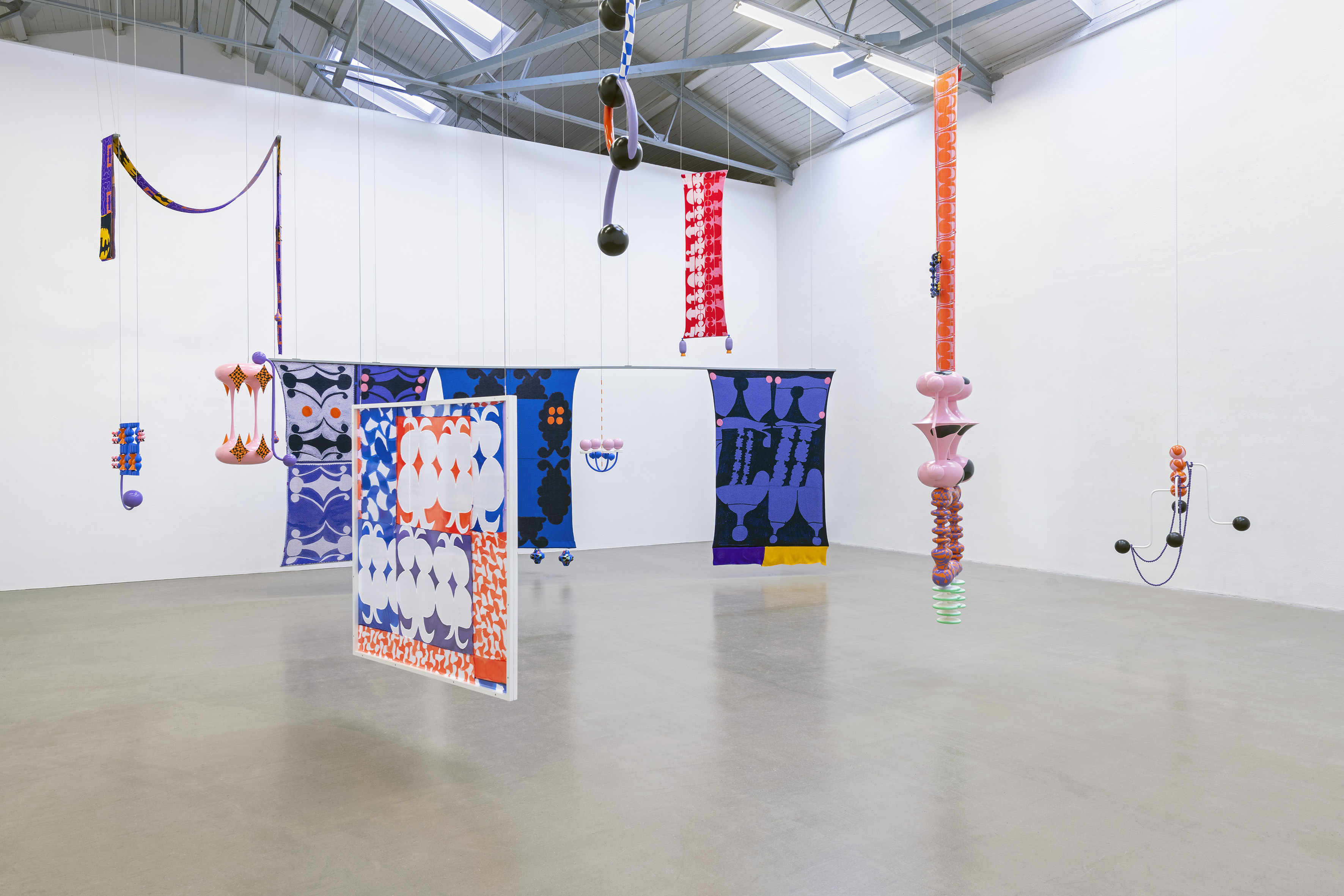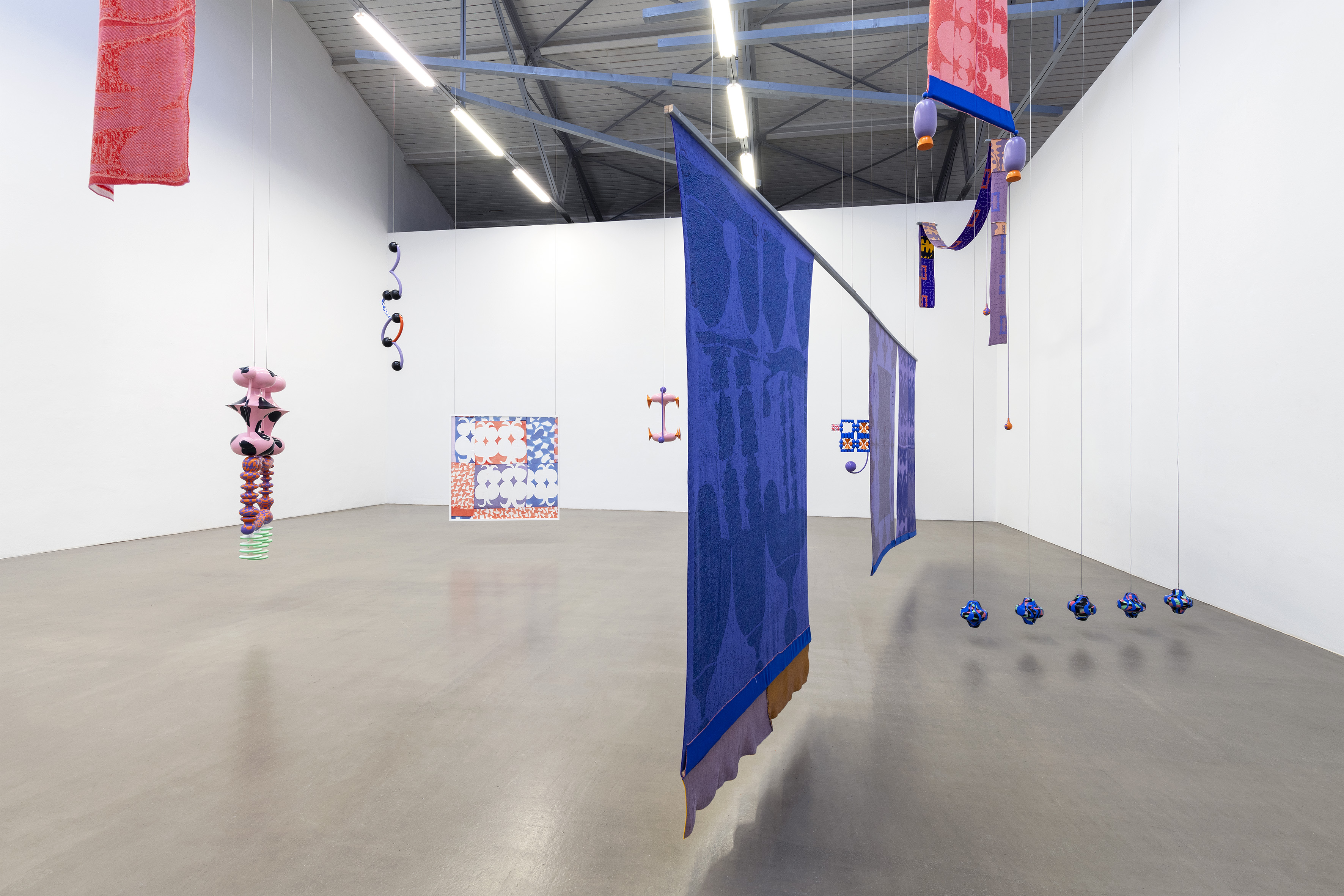Maja Behrmann
Findling
Galerie EIGEN + ART Leipzig
28 October – 16 December 2023
Maja Behrmann , Findling, Galerie EIGEN + ART Leipzig, October 28 - December 16, 2023
Camera + Editing: Paul Ott, Music: Purple
German, with English subtitles

Majascapes
Zaia Alexander
As I contemplate Maja Behrmann’s prolific oeuvre, I cannot help but consider the context in which her first solo exhibition at Galerie EIGEN + ART in Leipzig will be received—the domino- effect of invasions around the world, the suicidal war we humans have declared on our ailing, burning planet—the last two white rhinos, the mysterious disappearance of bats and bees, the ticking away extinction all manner of species, that endless pandemic.
Thankfully, these heartbroken words will not stand unchallenged:
Look! Look around! Look up!
Welcome to Maja Behrmann’s world—you will not want to leave.
Consider the electrifyingly vivid colors. Consider the exuberant life-affirming power of this wildly expanding body of work, the phantasmagoric figures dangling overhead, denizens from a distant realm.
Oh! And how they defy gravitas!
I had the opportunity to visit Maja Behrmann at her atelier this month which she jokingly refers to as her generator. This is where she works, and where she stores her exhaustive "archive of outlines," the stuff from which she draws her inspiration. Critics have marveled at the mind boggling virtuosity of her two- and three-dimensional structures made of wood, woven fabric, collages and all manner of media that seemingly have no "real world" function. (Note the word seemingly.) These pieces connect and communicate with each other through color and form, but there is a deeper layer of meaning encoded in them, a hidden dialogue that happens by nature of the source material: designs she discovers in collections of museums, cultural institutions, libraries, galleries, and in the objects of everyday life. An unheard of dialogue that takes place among wildly diverse shapes and forms and colors, a distillation that spans vastly diverse continents, eras, cultures and peoples. We can learn a lot from them. Behrmann begins each work with an outline that gets endlessly repeated in a variety of constellations, much like a composer, who gets fascinated by a series of notes that she translates into variations of variations.
As a writer, I understand the need to recycle words, thoughts, memories, characters, and actions. I get what it means to repeat certain forms and patterns rhythmically. Words we frequently use remind us that our writing— like our lives—is the sum of our obsessions. Behrmann likens her variations to a fountain that recycles the sparkling water spray into endless patterns within patterns. Just as no two snowflakes are alike, these variations reflect the true complexity of nature. The way each successive variation grows out of the previous one is profoundly logical to the point where it appears as inevitability.
During my visit, we spoke about all sorts of things— about literature, about what makes great art, and she left me with a couple of impressions that continue to resonate. We spoke, for example, about Paul Klee’s painting Angelus Novus, which Walter Benjamin was compelled to purchase, and which inspired his essay “Theses on the Philosophy of History.” I was delighted and surprised by this discovery. Walter Benjamin’s essays, particularly on translation, have been a mainstay of my thinking. And yet, how does this rather pessimistic, Thanatos-saturated view of the world mesh with the eros of Behrmann’s idyllic, ever-expanding technicolor world?

"A Klee painting named Angelus Novus shows an angel looking as though he is about to move away from something he is fixedly contemplating [...] This is how one pictures the angel of history. His face is turned toward the past. Where we perceive a chain of events, he sees one single catastrophe which keeps piling wreckage upon wreckage and hurls it in front of his feet. The angel would like to stay, awaken the dead, and make whole what has been smashed. But a storm is blowing from Paradise [...] The storm irresistibly propels him into the future to which his back is turned, while the pile of debris before him grows skyward. This storm is what we call progress."
Behrmann’s relentless creativity, the dizzying proliferation of objects (which she even finds somewhat uncanny), these dazzlingly colorful works are anything but facile or naively optimistic; they spring from the debris Benjamin is referring to, created in spite of.
Behrmann channels realms hidden beyond our immediate experience, dimensions entirely concealed from us; we cannot quite make use of the creaturely beings that populate them. Useless as they are (is it a sphinx, a torso, or a drunken Donald Duck?), we want to possess them, much like Benjamin needed to own the Angelus Novus. Their magical aura, their otherworldly beauty, their sensuous veneer entices us to caress and clad ourselves in them.
What vistas does the artist see before her, as she contemplates the forms that she must construct in order to see, eyes closed to the world? What might it be like to be so completely inside these byzantine bits of infinity? The mind staggers to enlarge itself sufficiently to allow all of these pieces in. Very practically, and without a hint of pretension, Behrmann tells me she doesn’t really know in advance the outcome of her work, because she cannot imagine how these objects function. Each piece must first be constructed before she understands them. The process has something to do with serendipity, with giving herself over to something she does not quite fully grasp. She prepares meticulously for this to happen, but then she must leave it up to chance, she must become an empty vessel for something else to emerge. And she must trust, for these pieces go through a number of transformations, which include collaborating with a trusted woodcarver from Dresden and a knitting mill. The question mark is essential for the work, being surprised by the outcome. It is this quality of serendipity that oxygenates and energizes the art, makes it magical.
And as much as these objects defy use, they also defy definition. We look at the two- and three-dimensional objects much like a Rohrschach blot, trying to make meaning of it like an old habit very difficult to kick, but these fluid and wild Majascapes slip past us. In this collection of her work at Galerie EIGEN + ART, we cannot even depend on gravity to fixate or situate the art.

The objects are suspended in space, as if to remind us they are not entirely here within our spatial reality. Yet, and this is essential, they are not hermetic works of art. At a very basic level, we sense they have everything to do with us. Much like the trunk of a tree that we caress
and that caresses us back, that we gaze at and that gazes back at us, these objects interact together and with us. They are not quite inanimate, nor are they designed to move. The work invites us to contemplate inter-being, engage in a dialogue with strangeness, right at a time when the conversation so often is focused on division.
The richness of variety in Behrmann’s works is astounding.
Paradoxically, it is precisely the natural limits of the material and its production that allow for an infinite number of variations. Indeed, the limitations are the anchor and the key to creativity. The wood that spins on its axis, or the weave that requires four threads. If the wooden object can only be symmetrical, Behrmann cuts it in half, paints it, incorporates the shavings left on the worktable. The weaver must use four color threads, yet when she joins one fabric to another, there are now eight colors.
Maja Behrmann's whimsical characters represent a radical defiance to the endless catastrophes of our time, the ‘piling up’ of disasters witnessed by the angel of history. And this defiance against the seemingly inevitable, this sparkling brio in the face of our present day crises makes them so profound. Ever so subtly, they point to a future beginning; there are no manifestos, no big words. Instead, we viscerally perceive Behrmann’s way of thinking, living and seeing: a world that, in its colorful exuberance, is precisely the counterpoint we so urgently need.